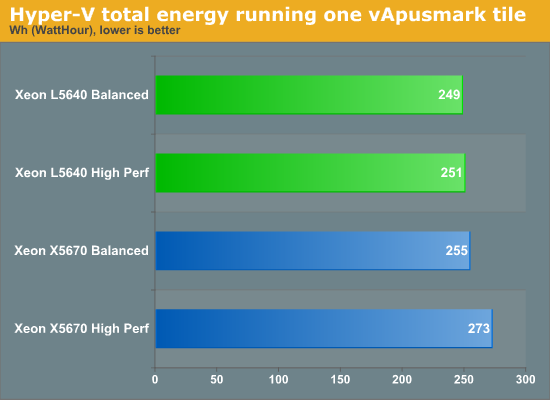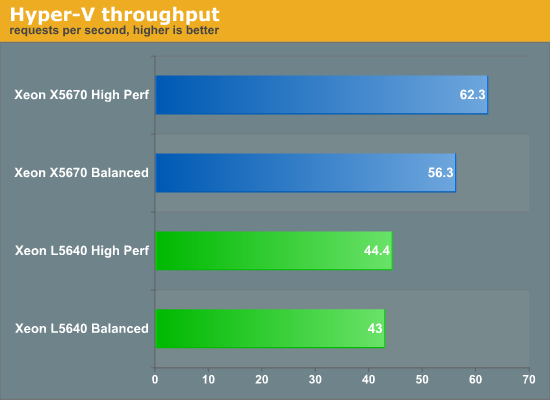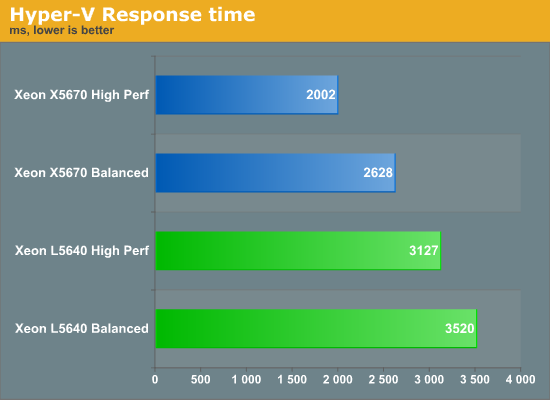Low Power Server CPUs: the energy saving choice?
by Johan De Gelas on July 15, 2010 4:54 AM EST- Posted in
- IT Computing
Energy measurements
So we measured the power over a period of 70 minutes (longer than the slowest test run), and calculated the real energy (power x time) consumed.


You can see that with the exception of the Xeon X5670 running with the high performance plan, there is almost no difference between the L5640 measurements and the “balanced” X5670. And let us look at performance now. We made a geometric mean of the number of URL/s and the number of database transactions that the server was able to process.

This graph explains why the Xeon X5670 does so well: as it is able to handle more transactions and web requests per second, it can empty the queues more quickly. When the web request and database queues are empty, the CPU can throttle back and save power. Since the idle power of the Xeon X5670 is pretty low (almost as good as the idle power of the low power version), this is a real tangible advantage.
Response time
At the end of day, users will not complain about throughput, they experience high response times as disturbing. Responses times are the ones that are part of the SLAs. Let us see what we measured. We made a geometric mean of the response time of the database queries and web requests.

The results are stunning! Despite the fact that we do not max out the CPUs at all, the X5670 leaves the low power version far behind when it comes to response times. This is partly due to the fact that vApus Mark I is constructed as a CPU test. In your own datacenter you might not see the same results if you are (partly) I/O constrained of course. But if web and database applications are well cached, the higher performing CPU can deliver tangible lower response times.










49 Comments
View All Comments
Zstream - Thursday, July 15, 2010 - link
It kills the AMD low power motto :(duploxxx - Thursday, July 15, 2010 - link
lol, all that you can say about this article is something about AMD. Looks like you need an update on server knowledge, Since the Arrival of Nehalem Intel has the best offer when you need the highest performance parts and when using Low power parts which give still the best performance. Since MC arrived things got a bit different mostly due to aggressive price for all mid value but still a favor to intel parts for highend and L power bins. Certainly in the area of virtualization AMD does very wellWhat is shown here should be known to many people that design virtual environments, Virtualization and low power parts don't match if you run applications that need cpu power and response all the time, L series can only be very useful for a huge bunch of "sleeping" vm's.
Interesting would be to compare with AMD, but 9/10 both low power and high power intel parts will be more interesting when you will only run 1 tile, the huge core amount lower ipc advantage will loose against the higher ipc/core of intel in this battle.
Zstream - Thursday, July 15, 2010 - link
Excuse me? I am quite aware of low power consuming chips. The point AMD has made in the past four to five years is that low power and high performance can match Intel's performance and still save you money. I have been to a number of AMD web conferences and siminars were they state the above.MrSpadge - Thursday, July 15, 2010 - link
Not sure if you're being sarcastic here, as it's obvious AMD would tell you this.
But regarding the actual question: you'd be about right if you compared K8 or Phenom I based Opterons with Core 2 based ones. And you'd be very right if you compared them to Phenom II. However, the performance of these Intels is being held back by the FSB and FB-DIMMs and power efficiency is almost crippled by the FB-DIMMs. But Nehalem changed all of that.
MrS
duploxxx - Friday, July 16, 2010 - link
4-5 years.... Nehalem was launched q12009 since then all changed. Before that Xeon parts suffered from FBDimm powerconsumption and FSB bottleneck and that is why AMD was still king on power/performance and was able to keep up with max performance. Nehalem was king, Istanbul was able to close the gap a bit but missed raw ghz and had higher power needs due to ddr2, again MC parts leveraged back this intel advantage and now there is a choice again, but L power still is king to Neh/Gulf.Penti - Saturday, July 17, 2010 - link
It invalidates low power versions of AMDs also. That's he's point I would believe.stimudent - Thursday, July 15, 2010 - link
Not really.If there can't be two sides to the story or a more diverse perspective, then it should not have been published. Next time, wait a little longer for parts to arrive - try harder next time.
MrSpadge - Friday, July 16, 2010 - link
A comparison to AMD would have been nice, but this article is not Intel vs. AMD!It already has 2 side: high power vs. low power Intels. And Johan found something very important and worthy of reporting. No need to blur the point by including other chips.
MrS
Zstream - Thursday, July 15, 2010 - link
I know we have the VMware results but could someone do an analysis on AMD / INTEL chips?For instance I can get a 12 core AMD chip or a 6 core/12 HT chip from Intel. Has anyone done any test with Terminal Servers or Real world usage of a VM (XP Desktop) with core count?
I would think that a physical 12C vs 6C impacts real world performance by a considerable large amount.
tech6 - Thursday, July 15, 2010 - link
Great work Anandtech - it's about time someone took the low power TCO claims to task.